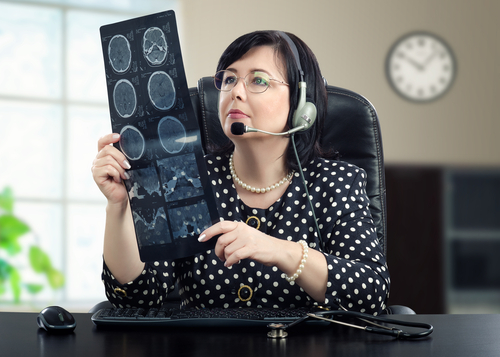Telemedicine Shows Promise for Parkinson’s Disease Care at Rush University Medical Center

Ann Johnson, a retired veterinarian diagnosed with Parkinson’s disease (PD) almost a decade ago, usually travels 130 miles from Champaign to Chicago to be treated by Dr. Christopher Goetz at the Parkinson’s Disease and Movement Disorders Center at Rush University Medical Center.
But her most recent appointment lasted less than 30 minutes and occurred in the quiet of her own living room.
Johnson is part of a pilot telemedicine project that will potentially allow many of her medical appointments to be conducted from her home via a secure live-streaming video.
“As a medical professional, I know the importance of developing innovative approaches,” Johnson said according to a recent news release. “When you see your vital signs right on the screen, it’s really quite neat.”
In telemedicine, medical information is exchanged from one site to another via electronic communications. Telemedicine includes a growing variety of applications and services using two-way video, email, smart phones, wireless tools and other forms of telecommunication technology.
But the diagnosis and clinical monitoring of Parkinson’s and other movement disorder progression is almost entirely based on clinical visual observation because no brain scans or blood tests can establish the diagnosis.
Rush University Medical Center helped create visual criteria many years ago for video technology that helps movement disease diagnosis and tracking disease progression.
Goetz was keen to demonstrate that the same subtle symptoms of PD progression or disease improvement evaluated in the clinic office, such as tremors, change in gait or in fine finger movements, could also can be evaluated in real-time through telemedicine.
Since October 2015, more than 20 patients in the medical center’s telemedicine project have used their own computers to link to Rush for virtual appointments with their neurologist. Presently, Goetz and neurologist Dr. Katie Kompoliti use the method, but other neurologists will be added to the virtual approach soon.
Patient feedback has been very positive.
Instead of signing in at the clinic, they instead log into Rush’s online health system to open a secure video feed. Neurologists then assess the patient face to face like a typical medical visit.
“Ninety-five percent of the information I gather is visual. Thus, with telemedicine visits where I can see and hear my patient right in front of me on the computer screen, there is no decline in the quality of information I gather,” Goetz said.
The term “virtual visit”, sometimes used to refer to telemedicine, is not acceptable to Goetz. When he sees patients via telemedicine, the relationship is truly one on one. The visit is not a simulation.
“It’s not like they are here, they are here – just in two dimensions,” he said. “We have our interaction right here in my office, but they have not had to travel.”
The time spent by patients via telemedicine versus clinical visits has also been considered, especially when actualizing the financial cost of heath care in clinical settings.
Results from a research study published in 2015 in the American Journal of Managed Care, showed that a typical office visit takes an average 121 minutes but only 20 of those minutes are spent with the doctor. The rest is waiting – which makes the patient time more valuable in dollars than clinician time.
For patients with advanced movement disorders who cannot drive, the cost of human time spent at medical appointments can be doubled because a second person is needed to bring the patient to the appointment.
Patient Alan Lundin said his medical visits to see Goetz in person, take him and his wife nearly 13 hours because they travel from Rockford.
“That’s pretty much the whole day spent on something that now takes half an hour,” Ludin said.
At Rush, telemedicine appointments are not charged to patients because the service is currently not covered by insurance in Illinois. Only half of U. S. states currently require private insurers to cover telemedicine the same as in-person visits. For now, Rush absorbs the price of the pilot telemedicine project.
“In order to prepare ourselves for the future, we are perfecting the system,” Goetz said. “Rush had the vision to set up the infrastructure and have everything in place so that when the day comes that we can be reimbursed for providing these services on a wider scale, we’ll be able to launch immediately.”
Dr. Brian Patty, Rush’s chief medical information office and chairman of the Telemedicine Steering Committee, said the pilot project will continue to meet patient needs.
“When the laws catch up with the technology, Rush will be ready,” Patty said,.






